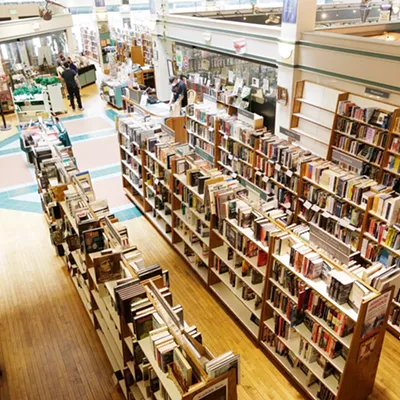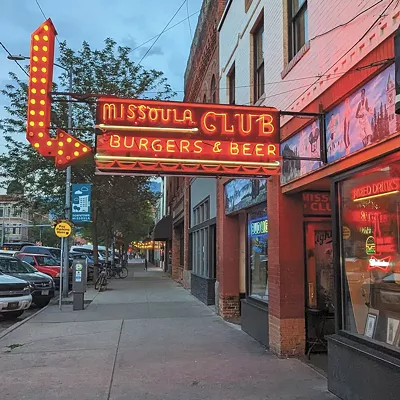On Jan. 30, Ben Joyce hosted a gathering at his downtown Spokane studio to reveal the first piece from what he's calling The Place Collection. The massive work, measuring 8 feet by 8 feet, depicted New York City using a blend of his familiar, map-like "abstract topophilia" aerial approach and fresh color and design flourishes inspired by interviews he conducted with locals on a week-long trip to the Big Apple. The piece was familiar thanks to the distinct style that's made Joyce popular, but showcased an artist clearly pushing himself in exciting new directions.
The plan Joyce described that night for The Place Collection was to travel the world throughout the year — followed by a documentary crew — talking to people in Shanghai, Moscow, Mexico City, Mumbai, Rio de Janeiro, Lagos, Florence, Abu Dhabi and Seattle, and then turning those experiences into 10 pieces (including New York City) and a film. The idea, he says, has been in his head for years.
Clearly, The Place Collection isn't going to happen as exactly planned. Joyce, 42, is holed up in his Indian Trail home with his wife, Erin, navigating the pandemic and keeping their three kids occupied and safe. We talked to Joyce about how the lockdown is going, and what his plans are for his now-delayed dream project. This interview has been edited for length and clarity.
INLANDER: What's your day-to-day life look like right now?
JOYCE: We're certainly trying to stick to this self-quarantine as much as possible. We really try to be as strict as we can as far as leaving the home and where we go, even what we touch. The hard thing is getting the kids [third-grader Cyrus, fifth-grader Nora and seventh-grader Ava] on a schedule, and even ourselves on a schedule. It's pretty nuts, but there's positives, too. We've never had as many family dinners in a row than we've had so far. It's going to be interesting to see what impact this is going to have on just family life and our connectivity to other people.
Before we talk about how things have changed, what was your original plan for this new series?
It's a project I've wanted to do for 15 years, to do this Place Collection that I go and observe a location, and not only through my own influence and observation, but [see it] through these interviews of people from all walks of life in their location. What does the place mean to them?
The timing of this [pandemic] is very complex in my thought process of this collection. We started in New York when COVID-19 wasn't even on the radar. So I have this experience in New York City, one of the biggest metropolises on Earth, and I remember being in Times Square, shoulder to shoulder with 50,000 people, maybe more. Just traveling through the city, there was never any regard for proximity to the next person. I must have rubbed shoulders with thousands of people during that week. Intentionally. So being able to create the New York piece from that experience is going to be critical in looking at this collection now as kind of a beginning, middle and end [of the pandemic].
How has the arrival of the virus changed your thinking on the project?
You go through different emotions, and there's times where it can become overwhelming, because now here I am doing this collection and it's a story that's going to be told right in the middle of coronavirus. So what does that look like as far as the composition I create?
We went to Seattle earlier this year, and at that point there were just three cases in Seattle, it had just made its way to the U.S. There was nothing on the level of awareness of the severity, there was no shutdown [yet]. We had five beautiful days in Seattle and within weeks, all of a sudden, Seattle takes on a whole different life from what I had experienced there. So part of creating the Seattle piece is to stay true to the time I had there. I could go back to paint New York or Seattle in current times, and it would look like a totally different piece. Creating the Seattle piece, it's reflective of the time I spent there, and that's something that'll stay true throughout this process. I was able to bring the Seattle piece to my garage, which is where I'm painting it now. This is forcing me to create work out of my element. And I certainly want this series to progress.
What are the next steps to keep it going?
Talking with the film director [Rudy Valdez], we're going to start reaching out to individuals across the globe to do weekly interviews [online]. The original concept of this collection was to study the connection to place in this moment in time. And that doesn't change. It's just going to be a totally different perspective.
In the next few months, or longer, international travel's probably out of the question. The cities [for The Place Collection] could certainly change. It's a challenge, but also an opportunity to connect with people who have lived this experience. I wonder what kind of impact that will have on my artwork. Could I find that it becomes even a more intimate project and relationship because of how you're connecting on this level of perspective of living life?
I think there was a reason why this didn't happen 15 years ago, or 10 years ago, or five years ago, and now it's all of the sudden here. How do I depict this moment in time? ♦
























